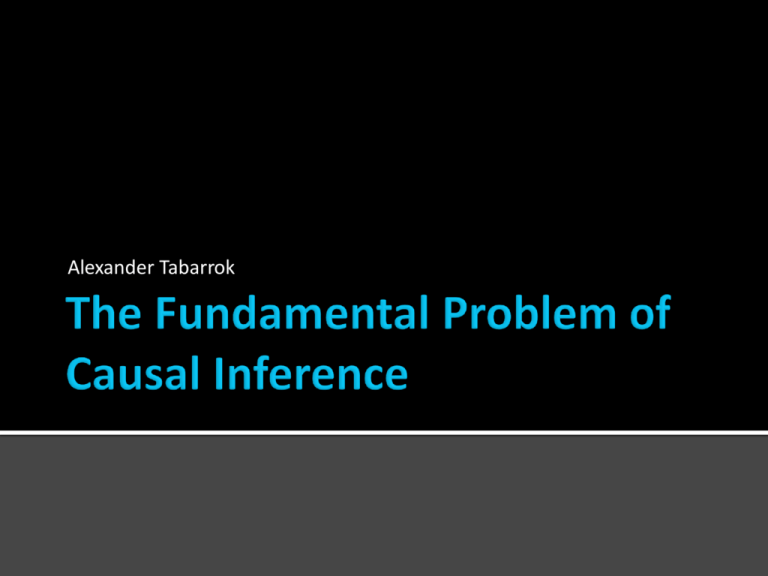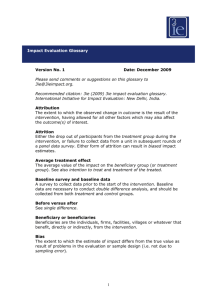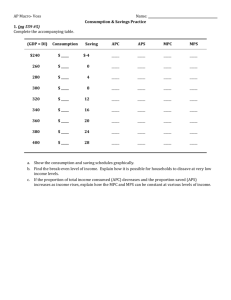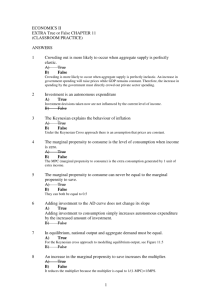Fundamental Probles of Causal Inference
advertisement

Alexander Tabarrok
T=Treatment (0,1)
YiT=Outcome for i when T=1
YiNT=Outcome for i when T=0
The average outcome among the treated
minus the average outcome among the
untreated is not, except under special
circumstances, equal to the average
treatment effect.
But is
interesting?
anything
The gold standard is randomization. If units are
randomly assigned to treatment then the selection
effect disappears.
i.e. with random assignment the groups selected for
treatment and the groups actually treated would have had
the same outcomes on average if not treated.
With random assignment the average treated minus
the average untreated measures the average
treatment effect on the treated (and in fact with
random assignment this is also equal to the average
treatment effect).
In a randomized experiment we select N individuals
from the population and randomly split them into two
groups the treated with Nt members and the untreated
with N-Nt.
In a regression context we can run the
following regression:
and BT will measure the treatment effect. It's
useful to run through this once in the simple
case to prove that this is true. See handout.
What if the assignment to the treatment is done
not randomly, but on the basis of observables?
This is when matching methods come in! Matching
methods allow you to construct comparison groups
when the assignment to the treatment is done on the
basis of observable variables.
Slide from Gertler et al. World Bank
If individuals in the treatment and control
groups differ in observable ways (selection on
observables) but conditional on the
observables there is random assignment then
there are variety of “matching” techniques.
Including exact matching, nearest neighbor
matching, regression with indicators,
propensity score matching, reweighting etc.
Five questions
1. I smoke.
2. I like to listen to music while studying.
3. I keep late hours.
4. I am more neat than messy.
5. I am male.
5^2=32 blocks (25 non-empty).
Within block, assignment is random!
For every 1 point increase (decrease) in the
roommate’s GPA, a student’s GPA increased
(decreased) about .12 points.
If you would have been a 3.0 student with a 3.0
roommate, but you were assigned to a 2.0 roommate,
your GPA would be 2.88.
Note that the peer effect in ability is 27% as large
as the own effect!
Peer effects are even larger in social choices such
as the choice to join a fraternity. (Dorm effects
are large here as well.)
Matching breaks down when we add covariates.
E.g. Suppose that we have two variables each with 10
levels, then we need 100 cells and we need treated
and untreated members of each cell.
Add one more 10 level variable and we need 1000
cells.
Regression “solves” this problem by imposing
linear relationships e.g.
Y=α + β1 PSA + β2 Age + β3 Age × PSA + β4 T
We have reduced (squashed!) a 100 variable problem
to 3 variables but at the price of assuming away most
of the possible variation.
Matching based on the Propensity Score
Definition
The propensity score is the conditional probability of
receiving the treatment given the pre-treatment variables:
p(X) =Pr{D = 1|X} = E{D|X}
Lemma 1
If p(X) is the propensity score, then D X | p(X)
“Given the propensity score, the pre-treatment variables are
balanced between beneficiaries and non- beneficiaries”
Lemma 2
Y1, Y0 D | X => Y 1, Y0 D | p(X)
“Suppose that assignment to treatment is unconfounded given the
pre-treatment variables X. Then assignment to treatment is
unconfounded given the propensity score p(X).”
Does the propensity score approach
solve the dimensionality problem?
YES!
The balancing property of the propensity score
(Lemma 1) ensures that:
o Observations with the same propensity score have the
same distribution of observable covariates
independently of treatment status; and
o for a given propensity score, assignment to treatment
is “random” and therefore treatment and control units
are observationally identical on average.
Implementation of the
estimation strategy
Remember we’re discussing a strategy for the estimation of the
average treatment effect on the treated, called δ
Step 1
Estimate the propensity score (e.g. logit or probit)
Step 2
Estimate the average treatment effect given the
propensity score
o
o
o
match treated and controls with “nearby” propensity scores
compute the effect of treatment for each value of the
(estimated) propensity score
obtain the average of these conditional effects
Step 2: Estimate the average treatment
effect given the propensity score
The closest we can get to an exact matching is to match
each treated unit with the nearest control in terms of
propensity score
“Nearest” can be defined in many ways. These different ways
then correspondent to different ways of doing matching:
o
o
o
Stratification on the Score
Nearest neighbor matching on the Score
Weighting on the basis of the Score
Rather than matching 1 to 1 it is possible to match 1 treated to all untreated
but adjusting the weights on the untreated to account for similarity. Uses
more data and is also unbiased.
When the objective is to estimate ATET, the treated person receives a weight of 1
while the control person receives a weight of p(X)/(1-p(X)).
n
n
pi
ATET n TiYi n (1 Ti )
Yi
1 pi
i 1
i 1
1
1
more efficient version
pi
wi
1 pi
n
n
wi
ATET n TiYi n (1 Ti )
Yi
i 1
i 1
wi
1
1
Matching Drops Observations
Not in “Common Support”
Density
Density of scores for
participants
Density of scores
for nonparticipants
Region of
common
support
0
Propensity score
1
High probability of
participating given X
Propensity Score Matching as Diagnostic and Explanatory Tool
The circle labeled "earnings" illustrates variation in the variable to be
explained. Education and Ability are correlated explanatory variables and
Ability is not observed. The blue area within the instrument circle
represents variation in education that is uncorrelated with Ability and
which can be used to consistently estimate the coefficient on education.
Note that the only reason the instrument is correlated with Earnings is
through education.
Instruments in Action
(Angrist and Krueger 1991)
Instrumental variables with weak instruments and correlation with unobserved
influences.
Bias in the IV estimator is determined by the covariance of the instrument with
education (blue within instrument circle) relative to the covariance between the
instrument and the unobserved factors (red within instrument circle). Thus IV
with weak instruments can be more biased than OLS.
Voluntary job training program
Say we decide to compare outcomes for those who
participate to the outcomes of those who do not participate:
A simple model to do this:
y = α + β1 P + β2 x + ε
P=
1
0
If person participates in training
If person does not participate in training
x = Control variables (exogenous & observed)
Why is this not working? 2 problems:
o Variables that we omit (for various reasons) but
that are important
o Decision to participate in training is
endogenous.
Problem #1: Omitted Variables
Even if we try to control for “everything”, we’ll miss:
(1) Characteristics that we didn’t know they mattered, and
(2) Characteristics that are too complicated to measure
(not observables or not observed):
o Talent, motivation
o Level of information and access to services
o Opportunity cost of participation
Full model would be:
y = γ0 + γ1 x + γ2 P + γ3 M1 + η
But we cannot observe M1 , the “missing” and
unobserved variables.
Omitted variable bias
True model is: y = γ0 + γ1 x + γ2 P + γ3 M1 + η
But we estimate:
y = β0 + β1 x + β2 P + ε
If there is a correlation between M1 and P, then the OLS
estimator of β2 will not be a consistent estimator of γ2, the
true impact of P.
Why?
When M1 is missing from the regression, the coefficient of
P will “pick up” some of the effect of M1
Problem #2: Endogenous
Decision to Participate
True model is:
with
y = γ 0 + γ 1 x + γ2 P + η
P = π0 + π 1 x + π 2 M2 +ξ
M2 = Vector of unobserved / missing characteristics
(i.e. we don’t fully know why people decide to participate)
Since we don’t observe M2 , we can only estimate a
simplified model:
y = β0 + β 1 x + β 2 P + ε
Is β2, OLS an unbiased estimator of γ2?
Problem #2: Endogenous
Decision to Participate
We estimate:
y = β 0 + β1 x + β2 P + ε
But true model is:
y = γ0 + γ1 x + γ2 P + η
with
P = π0 + π1 x + π2 M2 +ξ
Is β2, OLS an unbiased estimator of γ2?
Corr (ε, P)
= corr (ε, π0 + π 1 x + π 2 M2 +ξ)
= π 1 corr (ε, x)+ π 2 corr (ε, M2)
= π 2 corr (ε, M2)
If there is a correlation between the missing variables that
determine participation (e.g. Talent) and outcomes not
explained by observed characteristics, then the OLS
estimator will be biased.
What can we do to solve this
problem?
We estimate:
y = β0 + β 1 x + β 2 P + ε
So the problem is the correlation between P and ε
How about we replace P with “something else”,
call it Z:
o Z needs to be similar to P
o But is not correlated with ε
Back to the job training
program
P = participation
ε = that part of outcomes that is not explained
by program participation or by observed
characteristics
I’m looking for a variable Z that is:
(1)
(2)
Closely related to participation P
but doesn’t directly affect people’s outcomes Y, other
than through its effect on participation.
So this variable must be coming from
outside.
Generating an outside variable
for the job training program
Say that a social worker visits unemployed
persons to encourage them to participate.
o She only visits 50% of persons on her roster, and
o She randomly chooses whom she will visit
If she is effective, many people she visits will enroll.
There will be a correlation between receiving a visit and
enrolling
But visit does not have direct effect on outcomes
(e.g. income) apart from its effect through
enrollment in the training program.
Randomized “encouragement” or “promotion”
visits are an Instrumental Variable.
Characteristics of an
instrumental variable
Define a new variable Z
Z=
1
If person was randomly chosen to receive the
encouragement visit from the social worker
0
If person was randomly chosen not to receive the
encouragement visit from the social worker
Corr ( Z , P ) > 0
People who receive the encouragement visit are more likely
to participate than those who don’t
Corr ( Z , ε ) = 0
No correlation between receiving a visit and benefit to the program
apart from the effect of the visit on participation.
Z is called an instrumental variable
50
1400
30
40
Violent Crime Rate
1200
1000
800
600
20
400
1980
1985
1990
1995
2000
2005
Year...
Prison Population (1000s)
Violent Crime Rate
Violent Crime Rate is violent crimes per 1000 pop over the age of 12
Source: Bureau of Justice Statistics, http://www.ojp.usdoj.gov/bjs/
We have a running variable, X, an index with a
defined cut-off
o Units with a score X≤C, where C=the cutoff are eligible
o Units with a score X>C are not eligible
o Or vice-versa
Intuitive explanation of the method:
o Units just above the cut-off point are very similar to
units just below it – good comparison.
o Compare outcomes Y for units just above and below
the cut-off point.
The simplest RD design occurs if we have lots of
observations with X=C+ε (and thus T=0) and lots of
observations with X=C-ε (T=1) where ε is small.
In this case we can just compare means between the
two groups who are on either side of C+/-ε. Since the
two groups are similar to within an ε this estimates the
causal effect of treatment.
More typically, however, we will only have a few
observations clustered within ε of the cutoff value so
we need to use all of the observations to estimate the
regression line(s) around the cutoff value.
Goal
Improve agriculture production (rice yields) for small
farmers
Method
o Farms with a score (Ha) of land ≤50 are small
o Farms with a score (Ha) of land >50 are not small
Intervention
Small farmers receive subsidies to purchase fertilizer
Not eligible
Eligible
IMPACT
A linear model can be estimated very simply where X is the
running variable and T the treatment which occurs when X>C.
But this model imposes a number of restrictions on the data
including linearity in X and an identical regression slope for
X<C and X≥C.
Non-linearity may be mistaken for
discontinuity.
To handle this
we can
estimate
using, for
example:
One can allow different functions pre and post C.
Interpreting coefficients in a regression with interaction
terms can be tricky.
To aid in interpretation it's often useful to normalize the
running variable so it's zero at the cutoff. In this case, we
create a new variable 𝑋=X-C so X=0 at the cutoff then run:
In this case B₇ measures at 𝑋=X-C=0 which is the jump at C,
the estimate of the causal effect.
It's also possible to estimate the function in X using a nonparametric approach which is even more flexible.
Politicians are routinely reelected at 90%+
rates.
Is this because of advantages of incumbency
or is it because of a selection effect?
The best politicians will be the ones in the sample!
From Did Securitization Lead to Lax Screening? Evidence From Subprime
Loans (Benjamin J. Keys, Tanmoy Mukherjee, Amit Seru, Vikrant Vig)
Regression Discontinuity a Warning Heaping
Consider the following data from NYC
hygiene inspections (From NYTimes
http://fivethirtyeight.blogs.nytimes.com/2011/01/19
/grading-new-york-restaurants-whats-in-an-a/)
A restaurant receiving any score from 0 to
13 points gets an A, but the difference from
one end of that range to the other is
substantial. A zero score means that
inspectors found no violations at all, while
13 points means they found a host of
concerns. ..
The graph below shows the distribution of
A and B-rated restaurants…The horizontal
axis tracks the number of violation points,
and the vertical axis tracks the number of
restaurants scoring in that category. The
blue bars are A-rated restaurants, and the
green bars are B-rated.
This can also happen in more subtle ways,
e.g. Almond et al. (2010) study of low-birth
weight babies used 1500kg as RD. But
characteristics of patients at 1499 differ
from those at 1501. (Nurse control).






